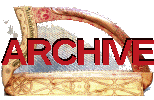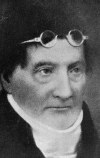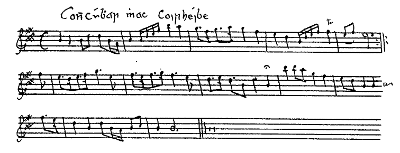
|
Sources for Gaelic harp music
the Bunting music manuscripts

Edward Bunting’s original commission from the organisers of the meeting in 1792, was to write down the ancient Irish tunes. So the most important part of the manuscripts he left behind him are the tune books. We do not have all of his music notebooks, but we do have a good number, enough to see his working methods from his little pocket field-notebooks through to big desk books where his piano arrangements were finalised ready for publication.
The numbering of the manuscripts at Queens is not very logical. You can check the PDF handlist or Collette Moloney’s Catalogue for details.
Edward Bunting’s live transcriptions from the playing of traditional musicians
From the point of view of Irish harp performance practice, the most important things in Bunting's manuscripts are the transcriptions from live performance of harpers.
MS4/29 is the most important single manuscript for old Irish harp music. It is a composite book, made up of a load of little
pamphlets which were apparently assembled together in about 1802. The pamphlets were used by Edward Bunting for making
transcriptions from harpers and other traditional musicians from 1792 onwards.
I used to call this “Bunting’s first field notebook” but I don’t think that is useful or true. We know
that it is not really a notebook, but an assembly of little booklets; and it seems that it does not contain transcriptions
made by Bunting at the 1792 Belfast Harp Festival. I think we are missing the Belfast Harp Festival transcription book;
the earliest notations in ms29
seem to date from Bunting's first collecting tours later in 1792.
MS29 continued to have things added by Bunting right through until 1805. The chronology of items is not at all clear. Many
items are not properly labelled, so we can have a transcription of a tune with no title, no date, no place, no informants name...
Often Bunting wrote other information about other people or places around the notation.
Bunting collected tunes from singers, pipers, fiddlers and harpers into the pamphlets and then into the assembled book. He also copied
tunes out of printed books into ms29.
There is a huge amount of information in this manuscript about the style and technique of the old harpers,
how they handled melody, ornament and bass. There are also brief comments in the margins, lists of tunes,
as well as other ephemeral information.
A digital facsimile of manuscript 29 is available online at the Queens website
I have transcribed the text, and am identifying the tunes, and categorising them as transcriptions or copies.
You can download my transcription in
PDF or
ODT format.
This can be used as a guide to
reading the online facsimile, or to help searching through the manuscript, or for statistical analysis. The files will
be updated as and when I get time. (2nd major revision 9 Jan 2020)
MS4/33(1) is a field notebook. It contains live field transcriptions, mostly from singers and traditional musicians,
but apparently not from harpers. There are tunes associated with the songs collected by Patrick Lynch in 1802, and it is very
possible that there are a number of song airs that come from the same performance or at least from the same singer as the lyrics
that Lynch transcribed.
At the back of the book, written very fast and upside-down, are live transcriptions from the playing of
harper Patrick Quin from County Armagh. These are perhaps the clearest and most complete transcriptions of old
Irish harp performance that we have. Another Quin harp transcription seems to have been inserted in a space in the main section of the book.
I have transcribed the text, and am identifying the tunes. You can download my transcription in
PDF or
ODT format. This can be used as a guide to
reading the manuscript, or for statistical analysis. The files will
be updated as and when I get time.
There are transcriptions in some of Bunting's other manuscripts. I am currently working through the manuscripts in a slightly ad-hoc way, searching for notations that look like they may have been transcribed live from the performance of tradition-bearers. Because these transcriptions are just occasional items or groups in manuscripts that are mostly piano arrangements, I am not transcribing and listing all the pages of each of these manuscripts, at this stage. That is a much bigger job that some-one else can do! You can download my transcription in PDF or ODT format.
For the latest updates, look on my news blog.
James Cody’s tune books
MS4/6 is a tune book written for Bunting by James Cody, in which he wrote song airs and words from about 1805 to 1809.
MS4/5 is a notebook, used from 1805 to 1810. James Cody wrote a load of tunes in this book, and Bunting also wrote tunes in. It is almost all just neat copes of melodies, not arranged for piano. Some of Bunting's notations seem to be connected to Cody. Donal O’Sullivan (1926, p.xxv) implies it is a continuation of manuscript 29 but that does not seem at all plausible.

MS4/5 p.20, facsimile from JIFSS VI, 1908, p.26. The tune of Conncúbhar mhac coirhéibe, as written down by James Cody.
MS4/33(4) is a tune book written by James Cody.
f24v_w400.jpg)
MS4/33(4) f24v, facsimile from JIFSS VI, 1908, p.18. The tune of Brian MacDermott Roe, by Carolan, as written down by James Cody.
Bunting’s piano arrangements
MS4/33(3) and MS33(2) are respectively volumes 1 and 2 of a pair titled Ancient and Modern Irish Music (not published)... for the harpsichord or pianoforte by E Bunting 1798. These are very spare keyboard arrangements which respect the ms29 drafts and seem to be an honest attempt to imitate the Gaelic harp style on the keyboards. Some of the tunes have extra information e.g. Gaelic titles, attributions to named harpers etc. It is my guess that this style of arranging was rejected by Bunting's publisher, since his next published work (1809) contains far more Romantic piano arrangements set with English lyrics commissioned for the book.
Ms4/33(5) appears to be piano arrangements planned for publication in about 1833, however this volume was never published.
MS4/30 is a book, mostly empty, containing piano arrangements. This is a pretty late book, written between 1832 and 1843 according to Collette Moloney. It has tune collected from Patrick Byrne as well as other Irish music. It also has English or Continental repertory written in a different hand from the other end.
A digital facsimile of MS30 is available online at the Queens website
MS4/12 consists of two boxes of loose sheets. Donal O’Sullivan (1926, p.xxv) said that they were piano arrangements of tunes later published in 1809 and 1840. However, the loose sheets in ms12 are actually a lot more diverse than that. There are pages and bifolios that have been taken out of a book of piano arrangements; there are fragments of another much smaller notebook that might have been used for field transcriptions; there are scraps and slips of paper that have been sent to Bunting in letters; there are one or two printed sheets; in other words ms12 is a random box of odds and ends, in no obvious sensible order. The Library at Queen’s has labelled each of the loose sheets; this does not correspond to the folio numbers in Colette Moloney’s cataloge so it is rather hard to find things or reference them!
MS4/20 contains some piano arrangements of Irish tunes, as well as continental music. I haven’t seen this.
MS4/34 is a box of loose music sheets that seem to have been sent to Bunting by various correspondents - he was always eager for people to send him tunes that they knew or had collected. I haven’t seen this.
MS4/13 and MS4/27 are large-format piano books. Donal O’Sullivan (1926, p.xxv) said that they are the actual piano arrangements that were printed in 1840. I think this is too simplistic; they do contain late piano arrangements of the 1840 tunes, but there are differences in the arrangements, and there are changes and corrections in different handwritings. None of this seems to me to be in Bunting’s handwriting; I am assuming that he had copies made and sent to his publisher, and they were emended and corrected by editors or collaborators. There is useful information about the tunes including attributions not found elsewhere, though it is not clear how reliable this information is.
Simon Chadwick